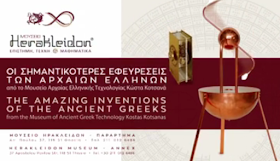 The exhibition “The Amazing Inventions of the Ancient Greeks” presents functional models of some of the most extraordinary ancient Hellenic inventions, from the 'robot-servant' of Philo and the 'hydraulic telegraph' of Aeneas to the 'cinema' of Hero, and from the automatic clock of Ctesibius and the astrolabe of Ptolemy to the 'analog computer' of Antikythera – a selection of the exhibits of the Museum of Ancient Greek Technology Kostas Kotsanas that operates at Katakolon port and Ancient Olympia, which were constructed after a long and extensive study of ancient Greek, Latin and Arabic literature, information from vase painting and the few relevant archaeological finds.
The exhibition “The Amazing Inventions of the Ancient Greeks” presents functional models of some of the most extraordinary ancient Hellenic inventions, from the 'robot-servant' of Philo and the 'hydraulic telegraph' of Aeneas to the 'cinema' of Hero, and from the automatic clock of Ctesibius and the astrolabe of Ptolemy to the 'analog computer' of Antikythera – a selection of the exhibits of the Museum of Ancient Greek Technology Kostas Kotsanas that operates at Katakolon port and Ancient Olympia, which were constructed after a long and extensive study of ancient Greek, Latin and Arabic literature, information from vase painting and the few relevant archaeological finds.This exhibition, the Archaeological News Network reports, aims to demonstrate that the technology of the ancient Hellenes, just before the end of the ancient Hellenic world, was shockingly similar to the beginning of our modern technology. An important cultural initiative, which promotes Greece internationally as the foundation of Western civilization.
Kostas Kotsanas, creator of the exhibition, notes that the bolts and nuts, gears and rules, pulleys and belts, sprockets and roller chains, pistons and cylinders, springs, hydraulic controllers and valves, programming devices and auto-pilots (all parts of the engine of a modern car) are just some of the inventions of the ancient Hellenes which were the foundations of their complex technology.
"These unique legacies continue to constitute today the building blocks of our modern technology, the development of which would be doubtful without the free and undemanding adoption of this ancient know-how. Humanity simply needed to mature another millennium in order to 'recover' this remarkable forgotten technology. The exploration of this age, when no claim to ownership of peak technology was made, demonstrates how much more (than we think) modern western technological civilisation owes to the Greeks."
The exhibition is on view at the Museum Herakleidon from the 1st of August through January 10th 2016. Below are some examples of these mechanisms. A while ago, I also did a post on ancient Hellenic technology and their many bright inventions. You can find that here.
The Automate Therapaenis (automatic maid) was the name of a technological miracle mentioned by Philo Byzantios during the 3rd c. BC. The maid was actually a life-sized doll holding an oenochoe ( wine-jug) with its one hand, having the other hand free and extended to receive a drinking vessel. The doll had a mechanism transferring wine and water from two pots interred in its body, to the jug she was holding, through tubes passing along her hand. Another set of tubes, going through her free hand and her body too, were there to enable pouring liquids by providing air. When somebody was placing a drinking vessel on her free hand, the wine (first) and the water (second) would come automatically from the wine-jug and they would stop once the drinking vessel was lifted
[Credit: Museum of Ancient Greek Technology]
[Credit: Museum of Ancient Greek Technology]
The clock of Archimedes was a complex hydraulic clock with many automatically moving objects. It consisted of the central storage container which supplied the water. The water went through a smaller container which ensured the stability of the water level (with a conical valve on a float), leading to the outflow nozzle. The supply of the flow was regulated depending on the date, turning the nozzle on a calibrated semicircular disc (so that the hypsometric difference of the nozzle hole and the level of water were altered, consequently, altering the time duration of the hour on the particular day). On the two columns of its facade, two rings (and two statuettes) indicated the hours that had been covered and the hours which remained respectively. On each hour, the pupils of the human eyes on a mask changed colour and a spherule fell into another container from the automatic opening of a crow's beak, with a bang. Simultaneously, the water fell into a volumetric container which, on the hour, was automatically reversed and two small snakes slid towards the birds on the tree that cried out frightened
[Credit: Museum of Ancient Greek Technology]
No comments:
Post a Comment